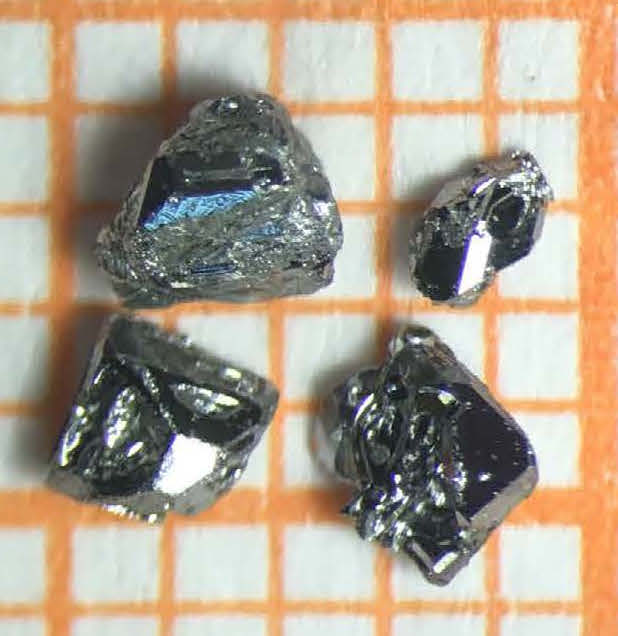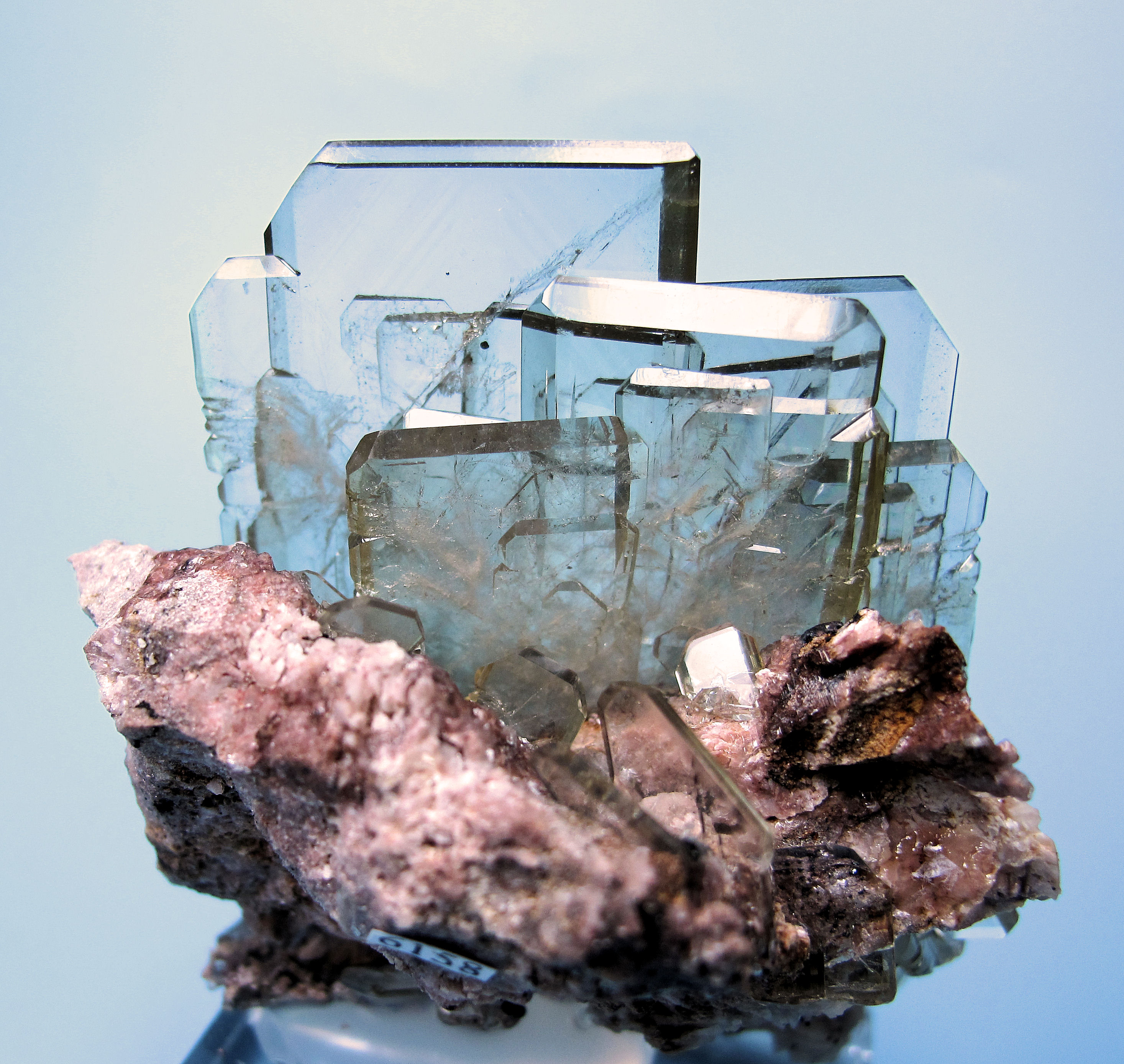|
Stannide
A stannide can refer to an intermetallic compound containing tin combined with one or more other metals; an anion consisting solely of tin atoms or a compound containing such an anion, or, in the field of organometallic chemistry an ionic compound containing an organotin anion (e.g.see an alternative name for such a compound is stannanide.) Binary alkali and alkaline earth stannides When tin is combined with an alkali or alkaline earth metal some of the compounds formed have ionic structures containing monatomic or polyatomic tin anions ( Zintl ions), such as Sn4− in Mg2SnS.M. Kauzlarich,(1994), Zintl Compounds, Encyclopedia of Inorganic Chemistry, John Wiley & sons, or in K4Sn9. Even with these metals not all of the compounds formed can be considered to be ionic with localised bonding, for example Sr3Sn5, a metallic compound, contains square pyramidal units. Ternary alkali and alkaline earth stannides Ternary (where there is an alkali or alkaline earth metal, a transition ... [...More Info...] [...Related Items...] OR: [Wikipedia] [Google] [Baidu] |
Yttrium Stannides
Yttrium and tin form several yttrium stannide intermetallic compounds. The most tin-rich is YSn3, followed by YSn2, Y11Sn10, Y5Sn4, and Y5Sn3. None survives above , at which point Y5Sn3 melts congruently. The enthalpy of dissolution is similar to the stannides of other late lanthanoids, and the intermetallics' overall enthalpies of formation resemble silicides, not germanides or plumbides. YSn3 is an electrical superconductor below . It was originally thought to be a Type I superconductor, but 7 K may actually be the strong-coupling regime, despite the low temperature. The density of electronic states has a local maximum at the Fermi level, composed of tin ''p'' and ''d'' orbitals. The intermetallic is difficult to form, slowly crystallizing from a mixture of Sn and YSn2 above . This may arise from competing allotropes near room temperature: although its crystal structure is certainly cubic, simulation indicates that both the tricopper auride ( Pmm) or alumi ... [...More Info...] [...Related Items...] OR: [Wikipedia] [Google] [Baidu] |
Dysprosium Stannides
Under standard conditions, the elements dysprosium and tin combine to form a number of intermetallic compounds, the dysprosium stannides. Dysprosium stannides with simple empirical formulas include Dy5Sn3 and DySn2, but four other intermetallics have intermediate composition. None is believed to survive temperatures higher than , whereat Dy5Sn3 decomposes. Although dysprosium is a lanthanoid, its ''f'' orbitals likely participate in the metallic bonding: mixing dysprosium and tin releases an enthalpy quite different from mixing samarium and tin, with gadolinium Gadolinium is a chemical element; it has Symbol (chemistry), symbol Gd and atomic number 64. It is a silvery-white metal when oxidation is removed. Gadolinium is a malleable and ductile rare-earth element. It reacts with atmospheric oxygen or moi ... and tin intermediate. DySn2 adopts the zirconium disilicide crystal structure, and undergoes a Néel transition around . The magnetic patterning below the Néel point ... [...More Info...] [...Related Items...] OR: [Wikipedia] [Google] [Baidu] |
Plumbide
Plumbide is an anion of lead atoms. There are three plumbide anions, written as Pb−, Pb2− and Pb4− with 3 oxidation states, −1, −2 and −4, respectively. A plumbide can refer to one of two things: an intermetallic compound that contains lead, or a Zintl phase compound with lead as the anion. Zintl phase Plumbides can be formed when lead forms a Zintl phase compound with a more metallic element. One salt that can be formed this way is when cryptand reacts with sodium and lead in ethylenediamine (en) to produce b5sup>2−, which is red in solution. Lead can also create anions with tin, in a series of anions with the formula n9−''x''Pb''x''sup>4−. Lead can also form the b9sup>4− anion, which is emerald green in solution. Examples An example of a plumbide is CeRhPb. The lead atom has a coordination number of 12 in the crystal structure of this compound. It is bound to four rhodiums, six ceriums, and two other lead atoms in the crystal structure of the chemica ... [...More Info...] [...Related Items...] OR: [Wikipedia] [Google] [Baidu] |
Intermetallic
An intermetallic (also called intermetallic compound, intermetallic alloy, ordered intermetallic alloy, long-range-ordered alloy) is a type of metallic alloy that forms an ordered solid-state compound between two or more metallic elements. Intermetallics are generally hard and brittle, with good high-temperature mechanical properties. They can be classified as stoichiometric or nonstoichiometic. The term "intermetallic compounds" applied to solid phases has long been in use. However, Hume-Rothery argued that it misleads, suggesting a fixed stoichiometry and a clear decomposition into species. Definitions Research definition In 1967 defined intermetallic compounds as ''solid phases containing two or more metallic elements, with optionally one or more non-metallic elements, whose crystal structure differs from that of the other constituents''. This definition includes: * Electron (or Hume-Rothery) compounds * Size packing phases. e.g. Laves phases, Frank–Kasper phases and ... [...More Info...] [...Related Items...] OR: [Wikipedia] [Google] [Baidu] |
Alkali
In chemistry, an alkali (; from the Arabic word , ) is a basic salt of an alkali metal or an alkaline earth metal. An alkali can also be defined as a base that dissolves in water. A solution of a soluble base has a pH greater than 7.0. The adjective alkaline, and less often, alkalescent, is commonly used in English as a synonym for basic, especially for bases soluble in water. This broad use of the term is likely to have come about because alkalis were the first bases known to obey the Arrhenius definition of a base, and they are still among the most common bases. Etymology The word ''alkali'' is derived from Arabic ''al qalīy'' (or ''alkali''), meaning (see calcination), referring to the original source of alkaline substances. A water-extract of burned plant ashes, called potash and composed mostly of potassium carbonate, was mildly basic. After heating this substance with calcium hydroxide (''slaked lime''), a far more strongly basic substance known as ''caustic potash ... [...More Info...] [...Related Items...] OR: [Wikipedia] [Google] [Baidu] |
Alkaline Earth
The alkaline earth metals are six chemical elements in group 2 of the periodic table. They are beryllium (Be), magnesium (Mg), calcium (Ca), strontium (Sr), barium (Ba), and radium (Ra).. The elements have very similar properties: they are all shiny, silvery-white, somewhat reactive metals at standard temperature and pressure. Together with helium, these elements have in common an outer s orbital which is full —that is, this orbital contains its full complement of two electrons, which the alkaline earth metals readily lose to form cations with charge +2, and an oxidation state of +2. Helium is grouped with the noble gases and not with the alkaline earth metals, but it is theorized to have some similarities to beryllium when forced into bonding and has sometimes been suggested to belong to group 2. All the discovered alkaline earth metals occur in nature, although radium occurs only through the decay chain of uranium and thorium and not as a primordial element. There hav ... [...More Info...] [...Related Items...] OR: [Wikipedia] [Google] [Baidu] |
Zintl Ions
Nanoclusters are atomically precise, crystalline materials most often existing on the 0-2 nanometer scale. They are often considered kinetically stable intermediates that form during the synthesis of comparatively larger materials such as semiconductor and metallic nanocrystals. The majority of research conducted to study nanoclusters has focused on characterizing their crystal structures and understanding their role in the nucleation and growth mechanisms of larger materials. Materials can be categorized into three different regimes, namely bulk, nanoparticles and nanoclusters. Bulk metals are electrical conductors and good optical reflectors and metal nanoparticles display intense colors due to surface plasmon resonance. However, when the size of metal nanoclusters is further reduced to form a nanocluster, the band structure becomes discontinuous and breaks down into discrete energy levels, somewhat similar to the energy levels of molecules. This gives nanoclusters similar qu ... [...More Info...] [...Related Items...] OR: [Wikipedia] [Google] [Baidu] |
Rare Earth Elements
The rare-earth elements (REE), also called the rare-earth metals or rare earths, and sometimes the lanthanides or lanthanoids (although scandium and yttrium, which do not belong to this series, are usually included as rare earths), are a set of 17 nearly indistinguishable lustrous silvery-white soft heavy metals. Compounds containing rare earths have diverse applications in electrical and electronic components, lasers, glass, magnetic materials, and industrial processes. The term "rare-earth" is a misnomer because they are not actually scarce, but historically it took a long time to isolate these elements. They are relatively plentiful in the entire Earth's crust (cerium being the 25th-most-abundant element at 68 parts per million, more abundant than copper), but in practice they are spread thinly as trace impurities, so to obtain rare earths at usable purity requires processing enormous amounts of raw ore at great expense; thus the name "rare" earths. Scandium and yttrium are ... [...More Info...] [...Related Items...] OR: [Wikipedia] [Google] [Baidu] |
Polyhedral Skeletal Electron Pair Theory
In chemistry the polyhedral skeletal electron pair theory (PSEPT) provides electron counting rules useful for predicting the structures of clusters such as borane and carborane clusters. The electron counting rules were originally formulated by Kenneth Wade, and were further developed by others including Michael Mingos; they are sometimes known as Wade's rules or the Wade–Mingos rules. The rules are based on a molecular orbital treatment of the bonding. These notes contained original material that served as the basis of the sections on the 4''n'', 5''n'', and 6''n'' rules. These rules have been extended and unified in the form of the Jemmis ''mno'' rules. Predicting structures of cluster compounds Different rules (4''n'', 5''n'', or 6''n'') are invoked depending on the number of electrons per vertex. The 4''n'' rules are reasonably accurate in predicting the structures of clusters having about 4 electrons per vertex, as is the case for many boranes and carboranes. For su ... [...More Info...] [...Related Items...] OR: [Wikipedia] [Google] [Baidu] |
Silicide
A silicide is a type of chemical compound that combines silicon and a usually more electropositive element. Silicon is more electropositive than carbon. In terms of their physical properties, silicides are structurally closer to borides than to carbides. Because of size differences however silicides are not isostructural with borides and carbides. Bonds in silicides range from conductive metal-like structures to covalent or ionic. Silicides of all non-transition metals have been described except beryllium. Silicides are used in interconnects. Structure Silicon atoms in silicides can have many possible organizations: *Isolated silicon atoms: electrically conductive (or semiconductive) CrSi, MnSi, FeSi, CoSi, , , , , , *Si2 pairs: , hafnium and thorium silicides *Si4 tetrahedra: KSi, RbSi, CsSi *Si''n'' chains: USi, , CaSi, SrSi, YSi *Planar hexagonal graphite-like Si layers: β-USi2, silicides of other lanthanoids and actinoids *Corrugated hexagonal Si layers: C ... [...More Info...] [...Related Items...] OR: [Wikipedia] [Google] [Baidu] |
Ethylenediamine
Ethylenediamine (abbreviated as en when a ligand) is the organic compound with the formula C2H4(NH2)2. This colorless liquid with an ammonia-like odor is a basic amine. It is a widely used building block in chemical synthesis, with approximately 500,000 tonnes produced in 1998. Ethylenediamine is the first member of the so-called polyethylene amines. Synthesis Ethylenediamine is produced industrially by treating 1,2-dichloroethane with ammonia under pressure at 180 °C in an aqueous medium (EDC process): : In this reaction hydrogen chloride is generated, which forms a salt with the amine. The amine is liberated by addition of sodium hydroxide and can then be recovered by fractional distillation. Diethylenetriamine (DETA) and triethylenetetramine (TETA) are formed as by-products. Another industrial route to ethylenediamine involves the reaction of ethanolamine and ammonia:Hans-Jürgen Arpe, Industrielle Organische Chemie, 6. Auflage (2007), Seite 275, Wiley VCH : Th ... [...More Info...] [...Related Items...] OR: [Wikipedia] [Google] [Baidu] |


